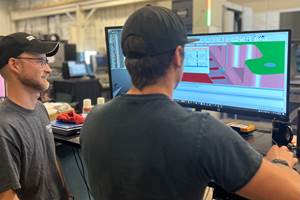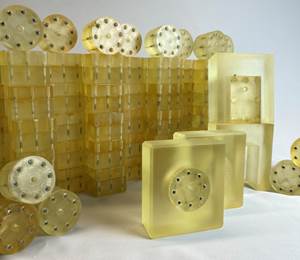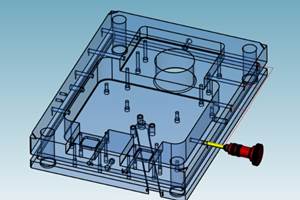EDM and Automation: The Present is the Future
By automating its EDM department, F&S Tool has been able to increase sales by 50 percent.
There is a sweeping change coming over the EDM industry - U.S. companies are looking for ways to compete with overseas competition where labor is cheap and plentiful. In the midst of this change, automation has clearly taken center stage of late. One needs only peruse the pages of most trade journals or walk the aisles of any trade show, to see what is happening. What you will see are robots, software, fixturing and a host of related products - all designed to assist you with "lights out" manufacturing.
Editorials comment on the high cost of doing business in the United States, and lament the unfair exchange rates that allow overseas competitors to purchase raw materials at lower prices. "Tier 1" companies' attempts to squeeze cost reductions and "retroactive rebates" out of any company doing business for them are examples of realistic "doom and gloom" scenarios.
Case stories also abound to counter these liabilities, each one a testament to the successful use of automation technology against these foes. Usually, only one part of the manufacturing process is highlighted, leaving the reader to wonder how the subject of the case study got to that point in the first place. Without a background chronology the average shop owner must be asking himself, "How do I compete if automation is changing the landscape so dramatically?" or, "Is my operation the kind that should be investigating this process?"
A Practical Blueprint
F&S Tool might just be the automation blueprint that other shops need to help chart their own EDM strategy. Located in Erie, Pennsylvania, this 45-man shop specializes in high precision mold building. Its facility is capable of producing four- and eight-cavity molds as well as high-cavitation stack molds as large as 2" x 64". It also specializes in one-cavity pre-production prototypes. Although conventional wisdom would have you believe the former to be its "bread and butter," its customers for the latter are the ones who best know F&S.
In the eyes of F&S' clients, it is desirable to place a small mold in the hands of a company where the task will not get lost in the shuffle. By maintaining a facility where a customer can always feel he has access to his parts, a high comfort level is established and the customer tends to feel that he is not just another number.
Of course, this product diversity comes at a price. Prototype molds are generally built on the "fast track" and in small numbers. To support these demands, F&S has had to develop routines to support short runs and fast turnarounds. Its facility operates around the clock. To avoid running its people into the ground, every effort is made to run the untended machine operations during the second and third shifts.
Grown-up Games
J.D Faulkner, vice president of F&S Tool, states, "There is a reason the serial number on our robot is #0001. If you want to come and play, you better bring your robot!" By recognizing the benefits of EDM automation early, F&S has been able to increase sales in 2000 by 50 percent. An important prerequisite to this growth was that it not compromise the delivery schedule that loyal customers had come to expect. A recent occurrence illustrates how the dream of untended operation fits well into real life. F&S' two automated sinkers were set up with workpieces and electrodes for a series of jobs that were run during the EDM operator's vacation. The cells were started on a Thursday and by the following Wednesday, the jobs were completely finished. As Faulkner states, "Even his [the operator's] absence did not jeopardize the delivery of the jobs. This I call efficiency."
A Journey of Unlimited Destinations
The beginning of this Automation Odyssey at F&S Tool was three years ago, with the installation of a 220-position robot on an existing mill. This machine had been dedicated to the manufacturing of electrodes and often had a difficult time keeping up with demand. Soon after the mill was automated, the electrode bottleneck was opened. Finished electrodes - produced overnight - were flowing into the EDM department. Soon thereafter, the EDM department became the laggard and, thus, a second robot was purchased and installed, this time on an existing sinker. Not only was electrode capacity increased in this machine - from the 16 positions of a toolchanger to the 88-position robot - but now workpiece palletization also was added to the process capacity of the EDM.
With all of this newly available "spark time," F&S' business was able to grow and a second sinker was soon added, this time equipped from the start with a next generation dual-machine robot. With a second automated EDM to support, the bottleneck again shifted to the electrode-making department. Capacity was increased with the purchase of a new mill. With it, another high capacity robot was purchased, for not only the new mill, but also as a retrofit on the existing robot-equipped mill. With these two machines now being served from one central robot, floor space was preserved without losing production capacity.
In an interesting turn of events, the now available robot from the first mill was not simply discarded, as so many machine-specific products are when equipment is upgraded. Rather, it was retrofit to serve F&S' sinker EDM, thus adding the service of another production-level EDM to F&S' growing and diverse customer base.
A Willing Risk-taker
F&S' willingness to be "first" has allowed the company to develop some insight into the future of automation in this industry. From Faulkner's experiences, he has concluded that it is imperative for machine tool manufacturers to, in his words, "get on the same page" as automation. His firsthand experience with three field retrofits and two OEM-assisted installations of automation make Faulkner an expert in the "behind the scenes" issues that are encountered along the way.
F&S also believes that in order to maximize the potential of automation, one must standardize on the tooling that links the machines. This helps avoid mechanical roadblocks between the machining processes. Faulkner says, "We wanted one partner in automation that could bridge all machines, regardless of make or model, and deliver a complete solution - tooling, software and robots."
Certainly, automation can provide the essentials. But potential users must be ready to get creative. Automation has helped F&S take on rush jobs that might frustrate most shops. F&S is continually working out ways of organizing internally that also help in these high-pressure situations. F&S has developed in-house, internal tracking software that allows it to monitor the jobs it is doing in real-time. This way, when the schedule is disrupted, F&S knows precisely where it is in all of its operations and can more easily develop a new schedule. As a hedge against the unexpected, all automated equipment is hooked to a paging system, designed to alert operators in the event of a problem, or simply to tell them that the job is finished.
The Future
F&S plans to continue targeting other processes for automation. Integrating a robot with two CNC 12 x 24 grinders is on the agenda. The addition of all the capacity in milling and EDM has resulted in a serious demand for more grinding time. This increase has, for the short term, forced F&S to operate this department with two shifts just to keep up. By automating this labor-intensive process, it fully expects the return on investment to be F&S' quickest, to date.
The Human Factor
The entire mindset at F&S is incredibly customer oriented, so it is easy to see why it can't go wrong. The company makes a point of having the best customer service possible and constantly strives to improve its performance. In only five years, F&S has grown 300 percent, yet it has managed to keep all of these customers satisfied with "relative ease," says Faulkner, because of the way the company is managed.
Four brothers own F&S, and each one takes an active interest in customer requests, and they collaborate every day on what is happening in the company. Faulkner says, "We feel the customers that deal with us have a higher level of confidence because they are talking to the owners of the company about their problems."
F&S keeps up with changing technology by focusing on the goal at hand - serving the customer. Machine tool manufacturers must follow suit, serving their customers by making tools that can be pushed as far as the technology of automation can take them. Companies of all kinds must invest in automation, because it is the inevitable future of this industry, and applicable to almost any level of machining.
The science of the change is simple - it's evolution. Companies like F&S that are early in employing automation are going to be one step ahead of the industry, so remember what J.D. Faulkner says, "If you want to compete in a global manufacturing business, a company must view all areas of efficiency. Adding more machines is simply not the answer. The answer is to get the most hours out of each machine, each and every day."
Related Content
CAD/CAM Software Reduces Delivery Times by 70% With a Six-Month ROI
Single integrated CAD/CAM package reduces translation errors, simplifies design process, improves shop efficiency and shortens tool lead times.
Read MoreCT Scanning Helps Micro Molder Reduce Cost of First Article Inspections
CT scanning services performed by 3D ProScan, a division of NyproMold Inc. provides MTD Micro Molding with accurate, high-resolution internal and external measurements performed about seven times faster and at significant cost savings.
Read MoreIn "Hybrid" FIM Process, 3D Printing Complements Injection Molding
Alpine Advanced Materials used a desktop 3D printer and the freeform injection molding process to reduce prototype tooling production time and cost for its customers.
Read MoreCAM Automation Increases Mold Production, Quality
Mold builder switches CAM software package after 20 years to take advantage of innovative programming strategies that reduce mold machining programming and processing times.
Read MoreRead Next
How to Use Continuing Education to Remain Competitive in Moldmaking
Continued training helps moldmakers make tooling decisions and properly use the latest cutting tool to efficiently machine high-quality molds.
Read MoreAre You a Moldmaker Considering 3D Printing? Consider the 3D Printing Workshop at NPE2024
Presentations will cover 3D printing for mold tooling, material innovation, product development, bridge production and full-scale, high-volume additive manufacturing.
Read MoreReasons to Use Fiber Lasers for Mold Cleaning
Fiber lasers offer a simplicity, speed, control and portability, minimizing mold cleaning risks.
Read More





















